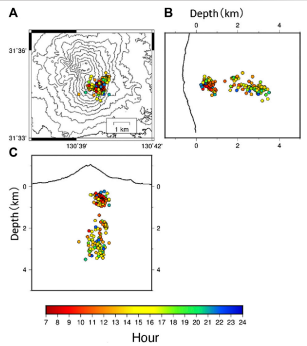Hi @agusms, thanks for providing the script and data! The code is as below.
Original GMT cross.bat script:
rem To plot eq and cross-section
gmt makecpt -Cred,green,blue -T0,70,300,10000 > quakes.cpt
gmt begin sumatra pdf
echo 100 -6 >line
echo 104 -2 >>line
echo 99.5 -6.2 A > word
echo 104.5 -1.5 B >> word
gmt coast -R95/115/-10/5 -JM4i -Bxa2g2 -Bya2g2pf3 -Glightbrown -B+t"Sumatra" -W0.25p
gmt plot eq.dat -Wfaint -Sc0.15 -Cquakes.cpt
gmt psxy line -JM -W2
gmt text word -JM -F+f15,Helvetica
gmt project eq.dat -Q -C100/-6.0 -E104.0/-2 -Fpz -W-100/100 > cross.dat
gmt basemap -JX10/-6 -R0/500/0/150 -Bxafg100+l"Distance" -Byafg50+l"Depth" -BWSen -Y-8
gmt psxy cross.dat -JX -Sc0.2 -W1 -Gred
echo 10 10 A > word2
echo 490 10 B >> word2
gmt text word2 -JX -F+f13,Helvetica
gmt end
Translated PyGMT v0.5.0 script:
import pygmt
fig = pygmt.Figure()
pygmt.makecpt(cmap="red,green,blue", series="0,70,300,10000", output="quakes.cpt")
fig.coast(
region=[95, 115, -10, 5],
projection="M4i",
frame=["xa2g2", "ya2g2pf3", '+t"Sumatra"'],
land="lightbrown",
shorelines="0.25p",
)
fig.plot(data="eq.dat", pen="faint", style="c0.15", cmap="quakes.cpt")
fig.plot(x=[100, 104], y=[-6, -2], projection="M", pen=2)
fig.text(x=99.5, y=-6.2, text="A", font="15,Helvetica")
fig.text(x=104.5, y=-1.5, text="B", font="15,Helvetica")
pygmt.project(
data="eq.dat",
unit=True,
center=[100, -6.0],
endpoint=[104.0, -2],
convention="pz",
width=[-100, 100],
outfile="cross.dat",
)
fig.basemap(
projection="X10/-6",
region=[0, 500, 0, 150],
frame=['xafg100+l"Distance"', 'yafg50+l"Depth"', "WSen"],
yshift=-8,
)
fig.plot(data="cross.dat", projection="X", style="c0.2", pen=1, color="red")
fig.text(x=10, y=10, text="A", font="13,Helvetica")
fig.text(x=490, y=10, text="B", font="13,Helvetica")
fig.savefig(fname="sumatra.pdf")
fig.show()
produces:
Hopefully you find it helpful!
Yes, but since you are just using 2 panels, it might be easier just to use xshift/yshift or fig.shift_origin. If you’re interested in making more complicated subplots, have a look at the tutorial at Making subplots — PyGMT.


